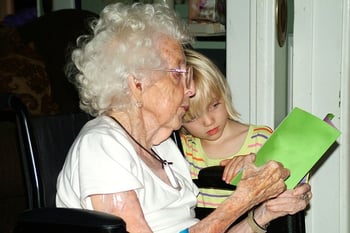Innovation. Does the very idea excite and terrify you at the same time? After all, innovation can lead to tremendous growth and success. It can take you in exciting new directions or help you make forward progress on your current path. At the same time, however, coming up with innovative ideas can be intimidating. Brainstorming often is accompanied by stress, anxiety, and blank stares. But here’s the good news: you already have a diamond mine of opportunities and ideas; you just need to learn to mine them.
Let’s start by taking the mystery out of innovation. This is simply a practical translation of ideas into new or improved products, services, systems, or social interactions. You may think of innovation as new ideas, but it’s more about a fresh way to look at situations, problems, products, and programs. It’s about how to turn challenges into opportunities and remain agile in a longevity economy where the ground is constantly moving under your feet.
Want innovative ideas? Look around. The ideas are everywhere—even in places you might not expect. For instance, Henry Ford didn’t invent the production line. He saw it working in a meat packing plant and adapted it for the automobile industry. The result—more efficient assembly and lower costs. Elsewhere, Starbucks looked around and saw an opportunity to provide coffee drinks with a high-end experience; and DeBeers produced industrial diamonds but saw a new market in engagement rings.
Watch Customers for Innovative Ideas
One approach to innovation is watching your customers. For instance, Avanti Senior Living saw the growing popularity of boutique hotels among older populations. These customers were attracted by the clean, bright, comfortable, convenient spaces; customized and easy-to-access service; and upscale attention to dining and other details. Avanti took this concept and applied it to senior housing. They established artfully designed spaces with thoughtfully provided health services, discreetly delivered on cue. Setting the scene for empowered, ageless, and heathy living, the dining hall resembles an elegant café, the exercise space an upscale gym.
Elsewhere, Latitude Margaritaville was inspired by the popularity of singer/songwriter Jimmy Buffett among baby boomers and other older Americans. The result is a number of planned communities featuring recreation, dining, and live entertainment with a tropical theme aimed at boomers.
What’s Your Cronut?
A few years ago, people were standing in block-long lines to buy a cronut—a combination of croissant and a donut. Bringing things together that people want and need can result in big innovation. For instance, consider The Pickens Center in Dallas, TX. It combines the best of hospice, home care, nursing care, and palliative care in one elegant setting spanning 9 acres. The center includes lake-facing patient care suites with balconies, family support areas, and more. And it also happens to be a destination educational resource and training center for best practices in hospice care. Another idea growing in popularity is combining the convenience and popularity of the local fitness center with the need for rehabilitation. Across the country, physical therapy and other rehab services are being offered right in the neighborhood gym—a more familiar and comfortable setting for many patients.
Everything Old Is New Again
Women often hold on to clothes or shoes for years because they know that old styles often become new trends. At the same time, ‘retro’ ideas, styles, and concepts from the past are more popular than ever. You can look to the past for ideas that might be ripe for a fresh look. For example, physician house calls were common in the 1950s and 1960s, but—due to time and cost restraints—they eventually disappeared. However, they are becoming popular again as technologies like Uber have emerged, family dynamics have changed, more homes have two working parents, and it has gotten more difficult for people to travel for care.
Another growing trend also takes from the past popularity of the home visit and combines it with cutting-edge technology. Increasingly, telemedicine services enable patients—especially those in rural locations—to receive personal ‘visits’ from physicians and other practitioners. As ideas such as this grow in popularity and their effectiveness and efficiency are documented, payors and others start to see the value. For instance, the Centers for Medicare & Medicaid Services pay for certain telemedicine services and private insurers are following suit as well.
Elsewhere, the popularity of communes—which popped up across the country back in the ‘60s—is returning in the form of senior and inter-generational cohousing communities. These intentional communities offer closer connections for residents and, in most cases, require them to contribute to the greater community.
Eliminate Something
While seeking innovations, consider the concept of ‘less is more.’ Is there a part of your product or service offering you might eliminate that would result in success? In recent years, some Continuing Care Retirement Communities (CCRCs) have identified that the average move-in age is trending upward and that a growing number of seniors aren’t as interested in leveraging their private home in favor of the campus lifestyle. Yet these consumers still need supportive services to remain in their homes. Thus evolved the concept of CCRCs without walls. These are care communities that provide the services of a CCRC without requiring that you move in to receive them. Staff and family to remotely monitor and coordinate healthcare and other sorts of support for residents in their own homes. This concept enables seamless care coordination, home health care service opportunities, remote assisted living and nursing care, touch-screen-based wellness programs, medication management, social engagement, and more. CCRCs without walls combine home- and community-base services with cutting-edge technology to make care convenient and accessible for seniors. In 2016, there were about 30 of these types of programs nationwide, with more in the works (https://seniorhousingnews.com/2016/06/02/3-keys-successful-ccrc-without-walls-program/).
Ready, Set, Innovate
Now that you realize you don’t have to start from scratch, you can stop stressing and start strategizing your innovations. Need more ideas? Check out these ‘hacks’ to innovation (LINK TO HACKS LIST), ideas you can use to take a fresh approach to older issues, revive tired products or services, or take your business in a new direction.
Start today. Build a culture of innovation. Make it part of what you and your team do; and provide incentives to come up with fresh ideas. Go beyond the usual, the same old, and what everyone else is doing. Just be sure to have a clear definition of what success looks like. Follow your innovations—test, measure, and adjust as needed.
Not every idea or innovation—even what may seem like a really good one—will be a hit. Be prepared to embrace failure and identify it before—and definitely IF—you get there. Recognize failures without blame or finger-pointing and celebrate successes. Your diamond mine is waiting; get your tools and start cultivating it.
To learn how Quantum Age can help you innovate successfully, request a consult.

.jpg?width=225&name=download%20(2).jpg)

.jpg?width=264&name=download%20(1).jpg)

 A
A 
 Generations United and LeadingAge that distills the results of a year-long study on the nature and extent of intergeneration programming in senior housing.
Generations United and LeadingAge that distills the results of a year-long study on the nature and extent of intergeneration programming in senior housing.